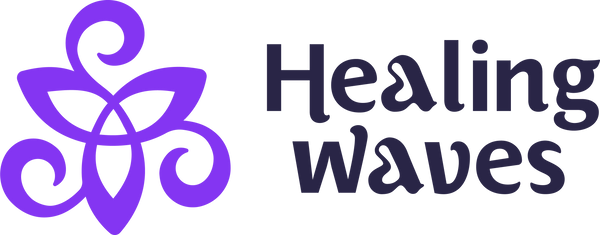Our Brain constructed from Billions upon Billions of Neurons At the root of all our thoughts, emotions and behaviors lays the communication between those neurons. Brainwaves are produced by synchronized electrical pulses from masses of neurons communicating with each other. Brainwaves are they way communities of neurons talk to each outer!
“Don't believe everything you think. Thoughts are just that - thoughts.” - Alan Lokos
Infra-Low (<0.5Hz)
Delta Waves (0.5 to 3 Hz)

Delta brainwaves are slow, loud brainwaves (low frequency and deeply penetrating, like a drumbeat). They are generated in deepest meditation and dreamless sleep. Delta waves suspend external awareness and are the source of empathy.
Delta Waves begin to appear in stage 3 of the sleep cycle, and by stage 4 dominate almost all EEG activity. At this stage, healing and regeneration are stimulated and are considered essential for the restorative properties of sleep. An excess of delta waves when a person is awake may result in learning disabilities and ADHD and make it extremely difficult to focus. It has been found that individuals with various types of brain injuries produce delta waves in waking hours, making it extremely difficult to perform conscious tasks. Sleepwalking and talking tend to occur while delta production is high.
As Healing and regeneration are stimulated in this state, we can understand why deep restorative sleep is so essential to the healing process of the Mind and Body.
Theta waves (3 to 8 Hz)

Theta brainwaves occur most often in sleep but are also dominant in deep meditation. Theta is our gateway to learning, memory, and intuition. In theta, our senses are withdrawn from the external world and focused on signals originating from within, we can understand it in a dream state where we can see, hear, feel, taste and smell. It is that twilight state which we normally only experience fleetingly as we wake or drift off to sleep. In theta, we are in a dream; vivid imagery, intuition and information beyond our normal conscious awareness. It’s where we hold our ‘stuff’, our fears, troubled history, and nightmares.
Theta waves are particularly involved in daydreaming and sleep. Cortical theta is observed frequently in young children, but in older children and adults, it tends to appear during meditative, drowsy, or sleeping states (but not during the deepest stages of sleep). When we are awake, excess theta levels can result in feeling scattered or day-dreamy and is commonly reported in ADHD. Too much theta in the left hemisphere is thought to result in a lack of organization, whereas too much theta on the right results in impulsivity. Theta in people with attention disorders is often seen more towards the front of the brain.
Frontal Midline Theta: Sinusoidal and high in amplitude (1-10 second bursts), generally occurs in response to events (ie. an ERP). This midline theta is associated with opening the sensory gate to the hippocampus for intermediate storage of episodic information. The frequency of frontal midline theta varies from 5-7.5 Hz, with an average of 6Hz. This rhythm is associated with working memory, episodic encoding and retrieval. It also appears during hypnosis and deep meditation. Frontal midline theta is thought to originate from the anterior cingulate. It mainly appears when one is performing a task requiring focused concentration, and its amplitude increases with the task load. It is mainly concentrated around Fz. When anxious and restless, the signal is reduced or even eliminated. When anxiety is medicated, the signal is restored. This suggests that the anterior cingulate cortex is involved in regulating the emotional state from restless anxiety to focused relaxation.
Alpha Waves (8 to 12 Hz)

Alpha brainwaves are dominant during quietly flowing thoughts and in some meditative states. Alpha is ‘the power of now’, being here, in the present. Alpha is the resting state of the brain. Alpha waves aid overall mental coordination, calmness, alertness, mind/body integration and learning.
Alpha tends to be highest in the right hemisphere, and too little alpha in the right hemisphere correlates with negative behaviors such as social withdrawal. This is also seen in people with depression, particularly with too much alpha frontally. Alpha is involved in active and adequate inhibition of the irrelevant sensory pathways.
Alpha is related to resource allocation in the cortex and is produced as a result of a resonance process between the thalamus and the cortex. If we consider the thalamus the gateway to the cortex, alpha can be thought of as the mechanism by which the sensory gate to the cortex can be closed.
Alpha appears to be closely involved with reticular activation and participates in binding mechanisms and resource allocation in regards to orientation and task sequences.
Alpha diminishes during sleep onset, while focusing on tasks, and is also a normal consequence of aging. When alpha slows and theta increases in frequency, it is often an indicator of pathologically slowed high-amplitude alpha, which is associated with Parkinson’s disease and cognitive decline. This indicates The degradation of myelination and cell death in the cortex and reflects growing metabolic inefficiency.
After completing a task and given feedback, the high functioning brain shows increased levels of alpha. This is associated with the consolidation of the task events, called post reinforcement synchronization (PRS). This represents an alpha burst in the brain when the brain is consolidating information.
Beta Waves (12 to 38 Hz)

Beta brainwaves dominate our normal waking state of consciousness when attention is directed towards cognitive tasks and the outside world. Beta is a ‘fast’ activity, present when we are alert, attentive, engaged in problem-solving, judgment, decision making, or focused mental activity.
Beta brainwaves are further divided into three bands; Lo-Beta (Beta1, 12-15Hz) can be thought of as a 'fast idle', or musing. Beta (Beta2, 15-22Hz) is high engagement or actively figuring something out. Hi-Beta (Beta3, 22-38Hz) is a highly complex thought, integrating new experiences, high anxiety, or excitement.
Continual high-frequency processing is not an efficient way to run our brains, and can result in tension and difficulties relaxing, and if present at night, can result in difficulties settling the mind and falling asleep. Beta waves tend to dominate in the left hemisphere, and too much beta on the right can be correlated with mania.
There are discrepancies regarding how the three levels of beta and gamma divide their territory in the brain. While it is widely agreed that higher beta frequencies are more correlated with arousal, some convincingly suggest that they are mostly a result of muscle artifact. For example, Heller et al. found that anxiety was highly correlated with elevated right hemisphere beta, and more recent work has found that insomnia is correlated with higher temporal lobe frequencies of beta, and migraines are associated with central high beta.
Gamma Waves (38 To 42 Hz)

Gamma brainwaves are the fastest of brain waves (high frequency, like a flute), and relate to simultaneous processing of information from different brain areas. Gamma brainwaves pass information rapidly and quietly. The most subtle of the brainwave frequencies, the mind has to be quiet to access gamma.
Gamma was dismissed as 'spare brain noise' until researchers discovered it was highly active when in states of universal love, altruism, and the ‘higher virtues’. Gamma is also above the frequency of neuronal firing, so how it is generated remains a mystery. It is speculated that gamma rhythms modulate perception and consciousness and that a greater presence of gamma relates to expanded consciousness and spiritual emergence.
Gamma is currently of limited clinical value, as it is argued that it cannot be effectively measured using current EEG technology, due to muscle contamination. While promising research has suggested that Gamma training can be successfully implemented to enhance intelligence, it will not be of proper clinical use until this issue of technology is resolved.
Gamma and theta work together to recruit neurons that stimulate local cell column activity. As such, it is associated with cortical processing related to cognitive functions, and is also potentially related to meditative states, although research on this relationship is vague.
“The greatest weapon against stress is our ability to choose one thought over another.” - William James
What Brainwaves Means for you:
Our brainwave profile and our daily experience of the world are inseparable. We cannot experience any form of reality without a corresponding change of brainwaves, When our brainwaves are out of balance, there will be corresponding problems in our emotional or neuro-physical health and vise Versa. Research has identified brainwave patterns associated with all sorts of emotional and neurological conditions.
Over-arousal in certain brain areas is linked with anxiety disorders, sleep problems, nightmares, hyper-vigilance, impulsive behavior, anger/aggression, agitated depression, chronic nerve pain, and spasticity. Under-arousal in certain brain areas leads to some types of depression, attention deficit, chronic pain, and insomnia. A combination of under-arousal and over-arousal is seen in cases of anxiety, depression, and ADHD.
Instabilities in brain rhythms correlate with tics, obsessive-compulsive disorder, aggressive behavior, rage, bruxism, panic attacks, bipolar disorder, migraines, narcolepsy, epilepsy, sleep apnea, vertigo, tinnitus, anorexia/bulimia, PMT, diabetes, hypoglycemia, and explosive behavior.
Altering your Brainwaves
Join our Community now, Facebook Community or Instagram Community
P.S- You Can our use, Meditation Music to get any of the Brainwaves states we have mentioned above, try it now, it will change your life!


